Abstract
1. Studies on the cytochrome spectra of liver mitochondria from control and glucagon-treated rats in State 4, State 3 and in the presence of uncoupler are reported. 2. The stimulation of electron flow between cytochromes c1 and c observed previously [Halestrap (1978) Biochem. J. 172, 399-405] was shown to be an artefact of Ca2+-induced swelling of mitochondria. 3. When precautions were taken to prevent such swelling, glucagon treatment was shown to enhance the reduction of cytochromes c, c1 and b558 in both State 3 and uncoupled conditions with either succinate or glutamate + malate as substrate. An increase in the reduction of cytochromes b562 and b566 was also seen in some, but not all, experiments. 4. In State 4 with succinate but not glutamate + malate as substrate, cytochromes c, c1, b558, b562 and b566 showed increased reduction. 5. Glucagon stimulated oxidation of duroquinol and palmitoylcarnitine by intact mitochondria and of NADH by disrupted mitochondria. 6. No effect of glucagon on succinate dehydrogenase activity or the temperature-dependence of succinate oxidation could be detected. 7. Glucagon enhanced the inhibition of the respiratory chain by colletotrichin, but not antimycin or 8-heptyl-4-hydroxyquinoline N-oxide. 8. These results are interpreted in terms of a primary stimulation by glucagon of the 'Q cycle' [Mitchell (1976) J. Theor. Biol. 62, 827-367] within Complex III (ubiquinol:cytochrome c oxidoreductase) and a secondary site of action involving stimulation of electron flow into Complex III from the ubiquinone pool. 9. Ageing of mitochondria, hyperosmotic treatment or addition of 20 mM-benzyl alcohol opposed the effects of glucagon treatment on cytochrome spectra and colletotrichin inhibition of respiration. 10. These results support the hypothesis that glucagon exerts its effects on the mitochondria by perturbing the membrane structure.
Full text
PDF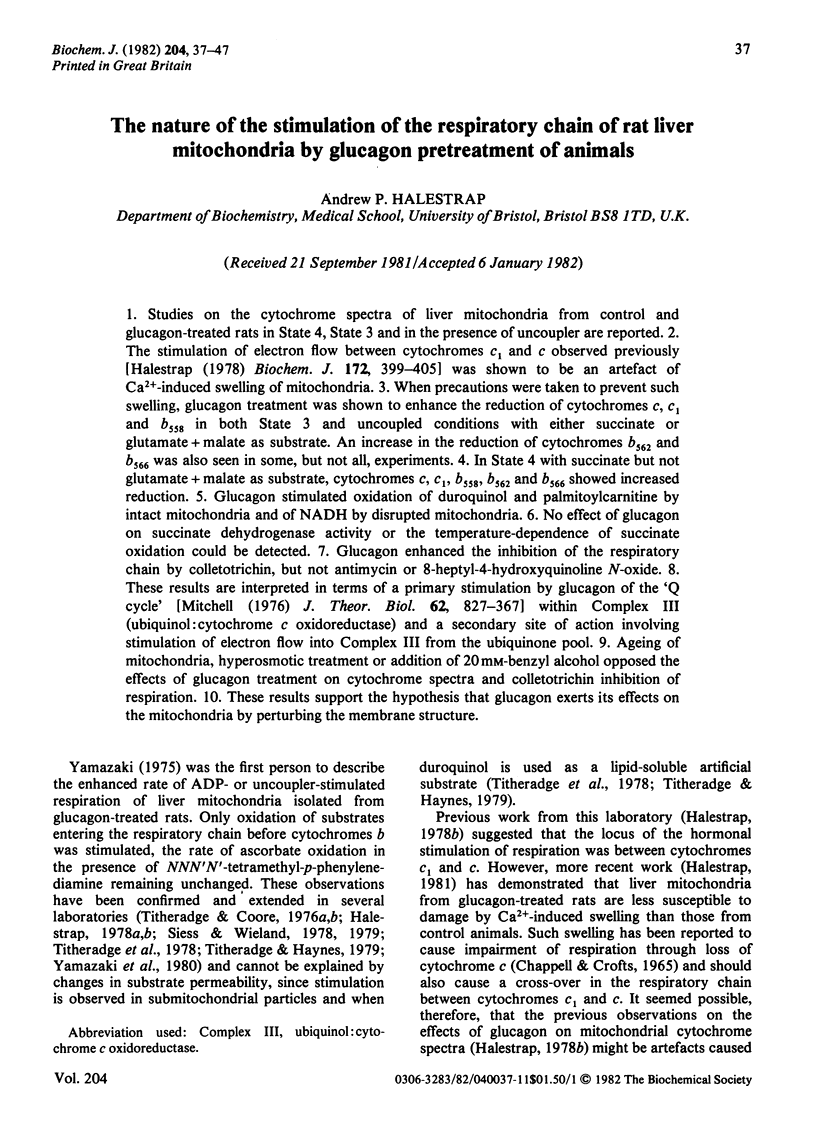

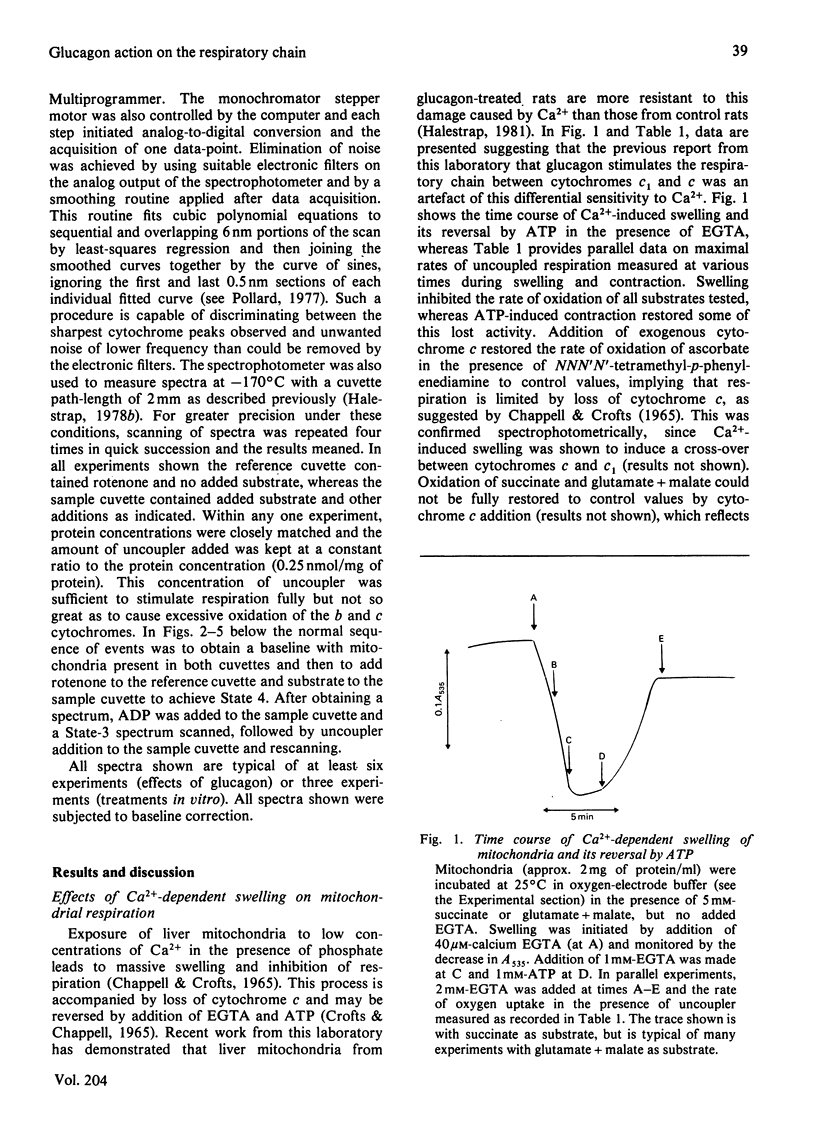
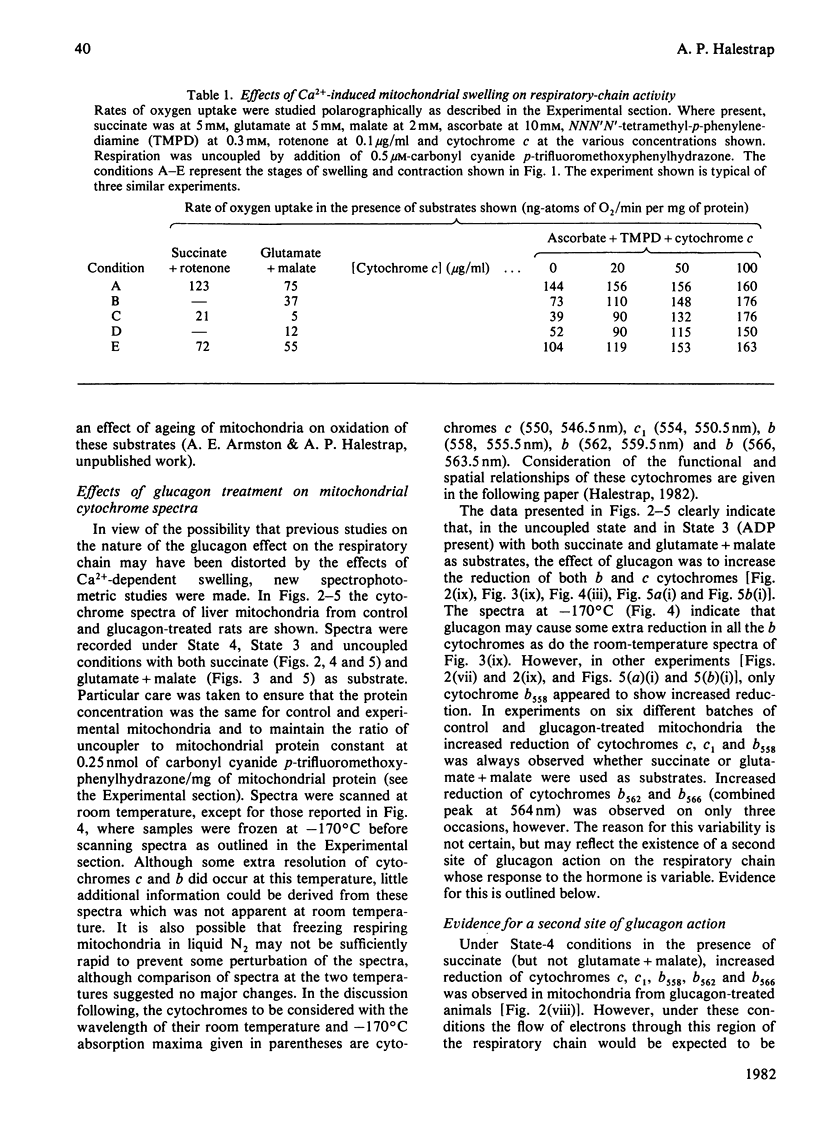



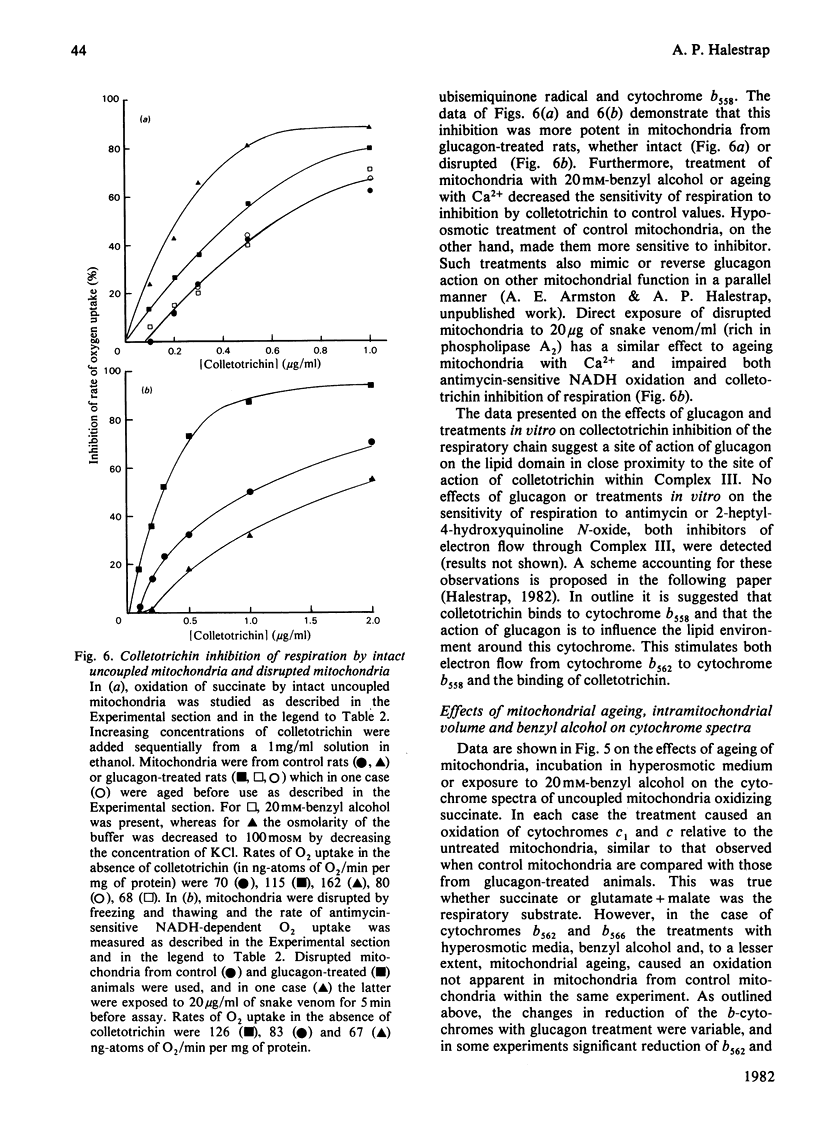
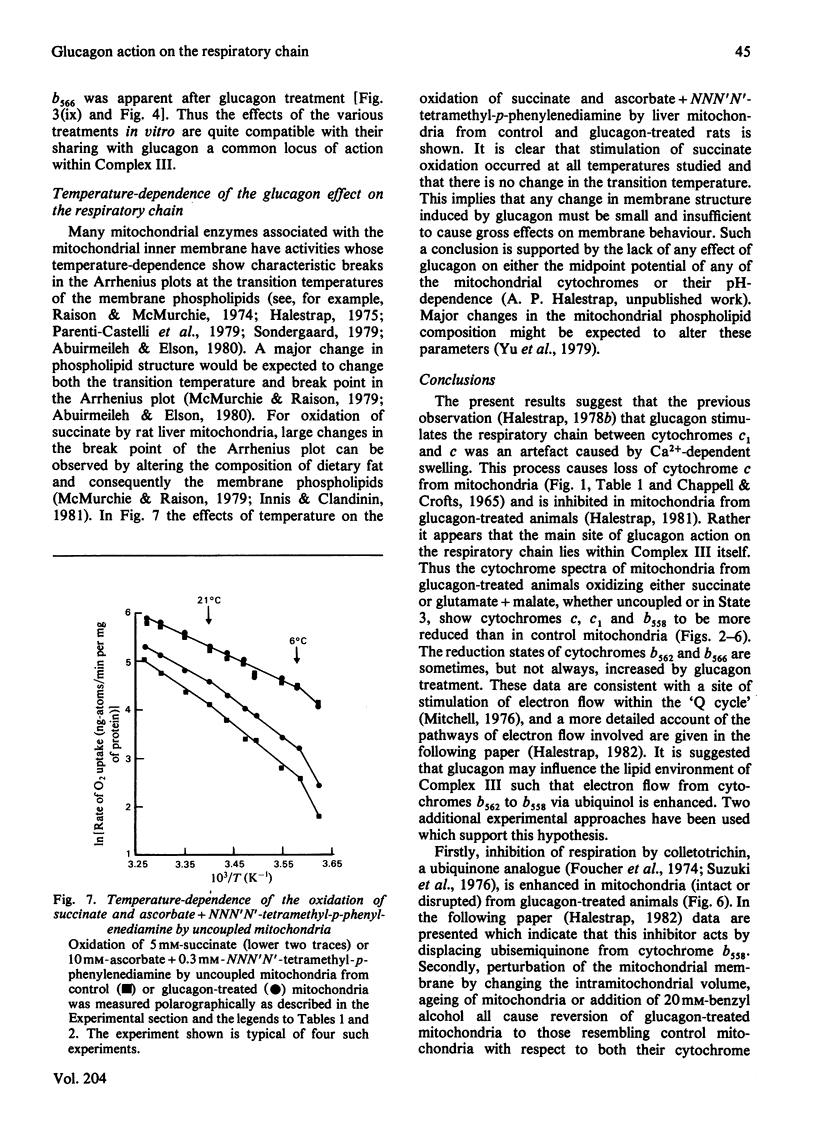


Selected References
These references are in PubMed. This may not be the complete list of references from this article.
- ARRIGONI O., SINGER T. P. Limitations of the phenazine methosulphate assay for succinic and related dehydrogenases. Nature. 1962 Mar 31;193:1256–1258. doi: 10.1038/1931256a0. [DOI] [PubMed] [Google Scholar]
- CHAPPELL J. B., CROFTS A. R. CALCIUM ION ACCUMULATION AND VOLUME CHANGES OF ISOLATED LIVER MITOCHONDRIA. CALCIUM ION-INDUCED SWELLING. Biochem J. 1965 May;95:378–386. doi: 10.1042/bj0950378. [DOI] [PMC free article] [PubMed] [Google Scholar]
- CROFTS A. R., CHAPPELL J. B. CALCIUM ION ACCUMULATION AND VOLUME CHANGES OF ISOLATED LIVER MITOCHONDRIA. REVERSAL OF CALCIUM ION-INDUCED SWELLING. Biochem J. 1965 May;95:387–392. doi: 10.1042/bj0950387. [DOI] [PMC free article] [PubMed] [Google Scholar]
- Foucher B., Chappell J. B., McGivan J. D. The effects of acetylcolletotrichin on the mitochondrial respiratory chain. Biochem J. 1974 Mar;138(3):415–423. doi: 10.1042/bj1380415. [DOI] [PMC free article] [PubMed] [Google Scholar]
- Halestrap A. P., Scott R. D., Thomas A. P. Mitochondrial pyruvate transport and its hormonal regulation. Int J Biochem. 1980;11(2):97–105. doi: 10.1016/0020-711x(80)90241-4. [DOI] [PubMed] [Google Scholar]
- Halestrap A. P. Stimulation of pyruvate transport in metabolizing mitochondria through changes in the transmembrane pH gradient induced by glucagon treatment of rats. Biochem J. 1978 Jun 15;172(3):389–398. doi: 10.1042/bj1720389. [DOI] [PMC free article] [PubMed] [Google Scholar]
- Halestrap A. P. Stimulation of the respiratory chain of rat liver mitochondria between cytochrome c1 and cytochrome c by glucagon treatment of rats. Biochem J. 1978 Jun 15;172(3):399–405. doi: 10.1042/bj1720399. [DOI] [PMC free article] [PubMed] [Google Scholar]
- Halestrap A. P. The mitochondrial pyruvate carrier. Kinetics and specificity for substrates and inhibitors. Biochem J. 1975 Apr;148(1):85–96. doi: 10.1042/bj1480085. [DOI] [PMC free article] [PubMed] [Google Scholar]
- Halestrap A. P. The pathway of electron flow through ubiquinol:cytochrome c oxidoreductase in the respiratory chain. Evidence from inhibition studies for a modified 'Q cycle'. Biochem J. 1982 Apr 15;204(1):49–59. doi: 10.1042/bj2040049. [DOI] [PMC free article] [PubMed] [Google Scholar]
- Hughes B. P., Barritt G. J. Effects of glucagon and N6O2'-dibutyryladenosine 3':5'-cyclic monophosphate on calcium transport in isolated rat liver mitochondria. Biochem J. 1978 Oct 15;176(1):295–304. doi: 10.1042/bj1760295. [DOI] [PMC free article] [PubMed] [Google Scholar]
- Innis S. M., Clandinin M. T. Dynamic modulation of mitochondrial inner-membrane lipids in rat heart by dietary fat. Biochem J. 1981 Jan 1;193(1):155–167. doi: 10.1042/bj1930155. [DOI] [PMC free article] [PubMed] [Google Scholar]
- LaNoue K. F., Schoolwerth A. C. Metabolite transport in mitochondria. Annu Rev Biochem. 1979;48:871–922. doi: 10.1146/annurev.bi.48.070179.004255. [DOI] [PubMed] [Google Scholar]
- McMurchie E. J., Raison J. K. Membrane lipid fluidity and its effect on the activation energy of membrane-associated enzymes. Biochim Biophys Acta. 1979 Jul 5;554(2):364–374. doi: 10.1016/0005-2736(79)90377-8. [DOI] [PubMed] [Google Scholar]
- Mitchell P. Possible molecular mechanisms of the protonmotive function of cytochrome systems. J Theor Biol. 1976 Oct 21;62(2):327–367. doi: 10.1016/0022-5193(76)90124-7. [DOI] [PubMed] [Google Scholar]
- Parenti-Castelli G., Sechi A. M., Landi L., Cabrini L., Mascarello S., Lenaz G. Lipid protein interactions in mitochondria. VII. A comparison of the effects of lipid removal and lipid perturbation of the kinetic properties of mitochondrial ATPase. Biochim Biophys Acta. 1979 Jul 10;547(1):161–169. doi: 10.1016/0005-2728(79)90104-x. [DOI] [PubMed] [Google Scholar]
- Prpić V., Spencer T. L., Bygrave F. L. Stable enhancement of calcium retention in mitochondria isolated from rat liver after the administration of glucagon to the intact animal. Biochem J. 1978 Dec 15;176(3):705–714. doi: 10.1042/bj1760705. [DOI] [PMC free article] [PubMed] [Google Scholar]
- Ragan C. I. The role of phospholipids in the reduction of ubiquinone analogues by the mitochondrial reduced nicotinamide-adenine dinucleotide-ubiquinone oxidoreductase complex. Biochem J. 1978 Jun 15;172(3):539–547. doi: 10.1042/bj1720539. [DOI] [PMC free article] [PubMed] [Google Scholar]
- Raison J. K., McMurchie E. J. Two temperature-induced changes in mitochondrial membranes detected by spin labelling and enzyme kinetics. Biochim Biophys Acta. 1974 Sep 6;363(2):135–140. doi: 10.1016/0005-2736(74)90053-4. [DOI] [PubMed] [Google Scholar]
- Siess E. A., Wieland O. H. Glucagon-induced stimulation of 2-oxoglutarate metabolism in mitochondria from rat liver. FEBS Lett. 1978 Sep 15;93(2):301–306. doi: 10.1016/0014-5793(78)81126-0. [DOI] [PubMed] [Google Scholar]
- Siess E. A., Wieland O. H. Isolated hepatocytes as a model for the study of stable glucagon effects on mitochondrial respiratory functions. FEBS Lett. 1979 May 15;101(2):277–281. doi: 10.1016/0014-5793(79)81025-x. [DOI] [PubMed] [Google Scholar]
- Sondergaard L. Role of proteins and lipids in non-linear Arrhenius plots of Drosophila mitochondrial succinate-cytochrome c reductase studied by rebinding experiments. Biochim Biophys Acta. 1979 Oct 19;557(1):208–216. doi: 10.1016/0005-2736(79)90103-2. [DOI] [PubMed] [Google Scholar]
- Titheradge M. A., Binder S. B., Yamazaki R. K., Haynes R. C., Jr Glucagon treatment stimulates the metabolism of hepatic submitochondrial particles. J Biol Chem. 1978 May 25;253(10):3357–3360. [PubMed] [Google Scholar]
- Titheradge M. A., Coore H. G. Hormonal regulation of liver mitochondrial pyruvate carrier in relation to gluconeogenesis and lipogenesis. FEBS Lett. 1976 Nov 15;72(1):73–78. doi: 10.1016/0014-5793(76)80901-5. [DOI] [PubMed] [Google Scholar]
- Titheradge M. A., Coore H. G. The mitochondrial pyruvate carrier, its exchange properties and its regulation by glucagon. FEBS Lett. 1976 Mar 15;63(1):45–50. doi: 10.1016/0014-5793(76)80191-3. [DOI] [PubMed] [Google Scholar]
- Titheradge M. A., Haynes R. C., Jr Glucagon treatment stimulates the oxidation of durohydroquinone by rat liver mitochondria. FEBS Lett. 1979 Oct 15;106(2):330–334. doi: 10.1016/0014-5793(79)80526-8. [DOI] [PubMed] [Google Scholar]
- Vignais P. V. Molecular and physiological aspects of adenine nucleotide transport in mitochondria. Biochim Biophys Acta. 1976 Apr 30;456(1):1–38. doi: 10.1016/0304-4173(76)90007-0. [DOI] [PubMed] [Google Scholar]
- Yamazaki R. K. Glucagon stimulation of mitochondrial respiration. J Biol Chem. 1975 Oct 10;250(19):7924–7930. [PubMed] [Google Scholar]
- Yamazaki R. K., Mickey D. L., Story M. Rapid action of glucagon on hepatic mitochondrial calcium metabolism and respiratory rates. Biochim Biophys Acta. 1980 Aug 5;592(1):1–12. doi: 10.1016/0005-2728(80)90109-7. [DOI] [PubMed] [Google Scholar]
- Yu C. A., Yu L., King T. E. Effect of phospholipid on the redox potential and enzymic properties of cytochromes b. Arch Biochem Biophys. 1979 Nov;198(1):314–322. doi: 10.1016/0003-9861(79)90424-7. [DOI] [PubMed] [Google Scholar]
- Yu L., Yu C. A., King T. E. The indispensability of phospholipid and ubiquinone in mitochondrial electron transfer from succinate to cytochrome c. J Biol Chem. 1978 Apr 25;253(8):2657–2663. [PubMed] [Google Scholar]


